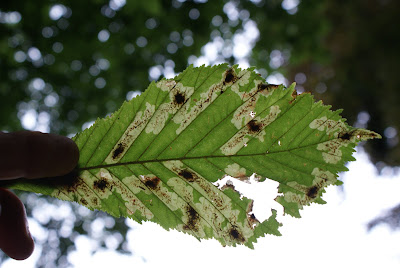
The leaf damage on this tree is caused by the aptly named Horse Chestnut Leaf Miner moth, Cameraria ohridella. It was only discovered in northern Greece in the 1970’s, but has since spread like wildfire through Europe, before being discovered infesting the trees on Wimbledon Common in July 2002. Since then it has continued to spread north through the UK at an alarming rate.
 The moth lays its eggs in the leaf tissue and the larva subsequently eats its way through the leaves, causing them to turn brown and shrivel. You can see the leaf mines in this photo, though I couldn’t find any with larvae present.
The moth lays its eggs in the leaf tissue and the larva subsequently eats its way through the leaves, causing them to turn brown and shrivel. You can see the leaf mines in this photo, though I couldn’t find any with larvae present.If this isn’t bad enough, there’s an even worse enemy attacking our Horse Chestnuts. This is the trunk of the same tree:

It’s suffering from Bleeding Canker.
As far as we know, this disease used to be limited to India where it caused minor damage to the leaves of the Indian Horse Chestnut but, since arriving in Europe - probably on imported timber - it has been wreaking havoc. Initially it was thought to be a fungal disease, but research has confirmed that it is, in fact, bacterial.
The tree starts to ‘bleed’ yellow or red liquid in the spring before it gets darker in warmer weather, drying up to leave the effect evident on the photo, though it may ‘bleed’ again when Autumn comes, the bacteria almost certainly preferring mild & moist conditions. It destroys much of the essential tissue in the tree and can cause all kinds of secondary effects.
Thankfully, there is some good news. Earlier this year, scientists in Norwich decoded the genome of the bacterium (which goes by the chilling name of Pseudomonas syringae pathovar aesculi, or Pae for short!), which will hopefully lead to a bit of genetic warfare. If we don’t want to see our Horse Chestnuts going the way of our Elm trees, a solution can’t come soon enough!
No comments:
Post a Comment